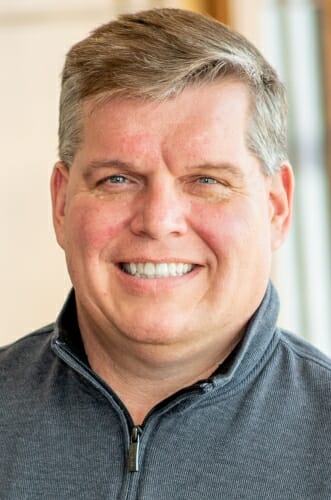WARF investment fund signals new tack in effort to grow adoption of UW–Madison technologies
A six-figure investment in a Wisconsin startup marks the latest effort by Wisconsin Alumni Research Foundation, the nation’s oldest technology transfer office, to adapt to the changing innovation landscape. The investment, from the new WARF Ventures project, will help PROMISS Diagnostics in Milwaukee advance a technology to diagnose ovarian cancer from blood samples.
PROMISS has licensed a WARF patent related to using machine learning to distinguish benign from malignant ovarian masses. The investment will fund retrospective clinical studies at Midwest hospitals and research institutions, and an FDA pre-submission application. “The initial study showed that the technology works but now we need to optimize it using different hospitals data,” says founder and CEO Jalal Sulaiman.
WARF has prospered for nine decades by licensing patents earned by UW–Madison inventors, delivering the 2019 dollar equivalent of $2.7 billion to fund the university. But “get-patent-and-license” is no longer the only way to earn money for WARF and its beneficiary, the University of Wisconsin–Madison, says Mike Partsch, WARF’s new chief venture officer.
Partsch, who has deep roots in startups nationwide, particularly in medical devices growing out of university inventions, came on board in 2018.
The goal of WARF Ventures, he says, is to help university startups climb out of the lab, cross the “valley of death” separating grant-funded life inside the university and independent existence as a business, and attract larger investments that will help reach profitability.
We sat down with Partsch to discuss WARF’s new venture fund.
Q: What is WARF Ventures?
A: We are a $110 million venture capital fund created by WARF with its own funds. Our primary mission is to support companies — through grant money and invested equity — that are developing technologies rooted at UW–Madison. Most of these will come from WARF’s collection of patents, or from other forms of IP (intellectual property), such as the copyrights for software.
Ultimately, the relatively large investments we make should bring along other venture capital funds. Speaking in generic terms, the startup business is built around milestones: first a patent, then a startup team, then a market analysis and a prototype, and regulatory approvals. Meeting each milestone takes money, and passing milestones typically attracts further investment.
We envision a virtuous spiral where one smart investment sparks successes, and then another, larger investment. Our role will be near the beginning of this process. We are smaller than venture funds on the coasts, but we do have connections there, and the Midwest is gaining a reputation as a source of great businesses.
Q: WARF has had a long history of success by licensing UW–Madison inventions. What changes in the entrepreneurial landscape have sparked the growing emphasis on investing in university-based startup innovations?
A: The attitude among industry partners has changed. A couple of decades ago, a pharmaceutical company might become intrigued with a new patent for a compound that seemed effective, say, against diabetes. But drug development is extremely costly, and the big tech companies have figured out that their real value-add is in sales and marketing, not early-on development of new compounds.
Industry wants more assurance that a patented process or material will succeed in the marketplace. In response, university technology transfer offices are seeking better ways to transform raw technologies into great products, which occurs more easily among startups. The projects that interest us need some extra progress in the university or a startup before they appeal to venture capitalists. We call this “proof of concept,” or the seed stage of company development, and that’s where we can make the most difference.
That, in short, is why WARF started WARF Ventures.
Q: You came on board six months ago. WARF started 93 years ago. How is it adapting?
A: WARF, as the nation’s first organization to license university inventions, has a long legacy of success and innovation. Although success can cause you to rest on laurels, we see WARF adjusting, changing, as it must.
Two other new programs acknowledge the changing landscape we just spoke about. WARF Therapeutics is advancing medicines. WARF Accelerator provides guidance and investment for promising projects that are not yet companies.
While these programs provide grant money to advance technology, WARF Ventures is dedicated to investing in an existing legal entity — in a company. We will work together, as WARF Accelerator and WARF Therapeutics are natural feeder programs for us.
I also do weekly “office hours” consulting for startups and entrepreneurs at UW Hospital room K6/110 and the Discovery Building, and likely at other locations soon. Scientists and entrepreneurs can come to chat — no charge and no obligation. I’ve already met some outstanding innovators with great ideas, people who said the equivalent of, “I am starting a company and don’t know the first thing about business.” But these are very smart people, and they learn fast.
Q: Does Wisconsin have the kind of entrepreneurial leadership that is needed for fast-growing startups?
A: Maybe not enough of it. We tend to have engineers, scientists, people who know the technology, but you need both. In California, we had entrepreneurs with experience from four or five companies. Some startups had succeeded, others had failed, but the entrepreneurs learned from both cases.
I think we will get the business side. We now have very successful companies on a high growth curve, like Epic and Exact Sciences, that are attracting talented team members and also inspiring others to start amazing businesses in Wisconsin. So it’s easy to anticipate that more management will move here. Success begets success, and this movement of management is parallel to the increase in investment I anticipate from outside the Midwest.

